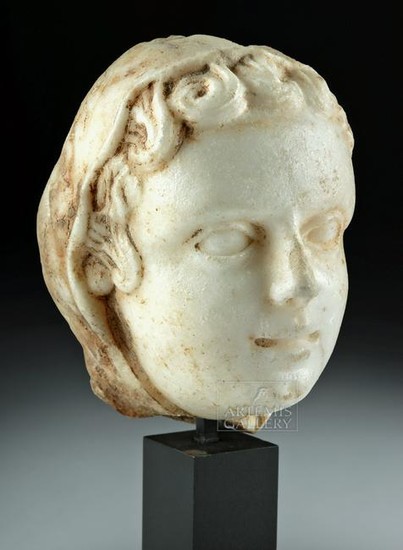Lovely Roman Marble Head of a Young Woman - ex-Bonhams
Roman, Imperial Period, ca. 1st century BCE to 1st century CE. A finely carved marble head of a young woman wearing a veil over her curly coiffure. Note how the sculptor made this marble come to life with her almond-shaped eyes, noble aquiline nose, slightly parted smiling lips, and cleft chin - all framed by meticulously delineated ringlets covered with a draping veil. That steadfast gaze is marvelously mesmerizing! A veil - also called a flammeum because of its yellow color akin to that of a candle flame -was traditionally worn by brides at Roman weddings. It was also associated with the veil worn by Flaminca Dialis, a Roman priestess who was not permitted to divorce her husband, the high priest of Jupiter, and therefore symbolized fidelity for life to one man. Size: 3.625" H (9.2 cm); 6.375" H (16.2 cm) on included custom stand.
Just who this sculpture represents is difficult to state definitively. She may simply be an anonymous woman or bride wearing a veil. However, her image also conjures that of the most famous Roman bride depicted wearing a pallium - Livia Drusilla, wife of the Roman emperor Augustus. (i.e. the Livia Drusilla statue from Paestum or the Statue of Livia found at Pompeii in the peristyle of the Villa of the Mysteries) Another possibility is that she represents one of the Vestal Virgins - priestesses of Vesta, the goddess of the hearth, who took a thirty year vow of chastity and were free of the obligation to marry and bear children, and also wore such veils.
A marble sculpture of Livia (ca. second half of 1st century CE) wearing a pallium may be seen at the Vatican Museums, Pius-Clementine Museum, Gallery of the Busts, 52. Another marble bust of Livia wearing a pallium, ca. 1st century BCE to 1st century CE is in the collection of the Getty Museum (73.AA.50).
Provenance: private Florida, USA collection, purchased at Bonhams, November 2002; ex-private London, England, United Kingdom collection
All items legal to buy/sell under U.S. Statute covering cultural patrimony Code 2600, CHAPTER 14, and are guaranteed to be as described or your money back.
A Certificate of Authenticity will accompany all winning bids.
We ship worldwide to most countries and handle all shipping in-house for your convenience.
#138669
Condition Report: Losses to back of head and neck as shown. Normal surface wear with slight abrasions to nose, left cheek, areas of veil, and chin as shown. Earthen and mineral deposits, particularly in recessed areas.
View it on
Estimate
Time, Location
Auction House
Roman, Imperial Period, ca. 1st century BCE to 1st century CE. A finely carved marble head of a young woman wearing a veil over her curly coiffure. Note how the sculptor made this marble come to life with her almond-shaped eyes, noble aquiline nose, slightly parted smiling lips, and cleft chin - all framed by meticulously delineated ringlets covered with a draping veil. That steadfast gaze is marvelously mesmerizing! A veil - also called a flammeum because of its yellow color akin to that of a candle flame -was traditionally worn by brides at Roman weddings. It was also associated with the veil worn by Flaminca Dialis, a Roman priestess who was not permitted to divorce her husband, the high priest of Jupiter, and therefore symbolized fidelity for life to one man. Size: 3.625" H (9.2 cm); 6.375" H (16.2 cm) on included custom stand.
Just who this sculpture represents is difficult to state definitively. She may simply be an anonymous woman or bride wearing a veil. However, her image also conjures that of the most famous Roman bride depicted wearing a pallium - Livia Drusilla, wife of the Roman emperor Augustus. (i.e. the Livia Drusilla statue from Paestum or the Statue of Livia found at Pompeii in the peristyle of the Villa of the Mysteries) Another possibility is that she represents one of the Vestal Virgins - priestesses of Vesta, the goddess of the hearth, who took a thirty year vow of chastity and were free of the obligation to marry and bear children, and also wore such veils.
A marble sculpture of Livia (ca. second half of 1st century CE) wearing a pallium may be seen at the Vatican Museums, Pius-Clementine Museum, Gallery of the Busts, 52. Another marble bust of Livia wearing a pallium, ca. 1st century BCE to 1st century CE is in the collection of the Getty Museum (73.AA.50).
Provenance: private Florida, USA collection, purchased at Bonhams, November 2002; ex-private London, England, United Kingdom collection
All items legal to buy/sell under U.S. Statute covering cultural patrimony Code 2600, CHAPTER 14, and are guaranteed to be as described or your money back.
A Certificate of Authenticity will accompany all winning bids.
We ship worldwide to most countries and handle all shipping in-house for your convenience.
#138669
Condition Report: Losses to back of head and neck as shown. Normal surface wear with slight abrasions to nose, left cheek, areas of veil, and chin as shown. Earthen and mineral deposits, particularly in recessed areas.



